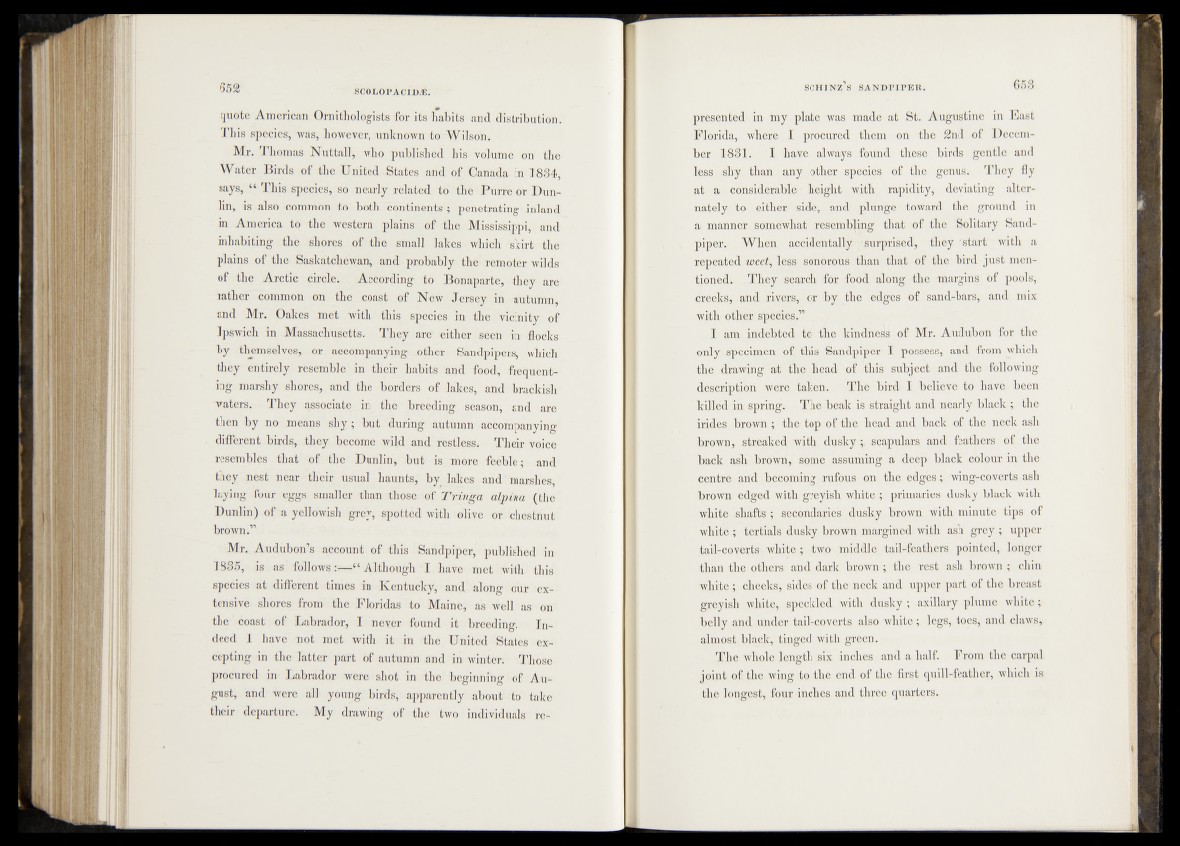
quote American Ornithologists for its habits and distribution.
This species, was, however, unknown to Wilson.
Mr. Thomas Nuttall, who published his volume on the
Water Birds of the United States and of Canada in 1834,
says, “ This species, so nearly related to the Purre or Dunlin,
is also common to both continents; penetrating inland
in America to the western plains of the Mississippi, and
inhabiting the shores of the small lakes which skirt the
plains of the Saskatchewan, and probably the remoter wilds
of the Arctic circle. According to Bonaparte, they are
rather common on the coast of New Jersey in autumn
and Mr. Oakes met with this species in the vicinity of
Ipswich in Massachusetts. They are either seen in flocks
by themselves, or accompanying other Sandpipers, which
they entirely resemble in their habits and food, frequenting
marshy shores, and the borders of lakes, and brackish
waters. They associate in the breeding season, and are
then by no means sh y ; but during autumn accompanying
different birds, they become wild and restless. Their voice
resembles that of the Dunlin, but is more feeble; and
they nest near their usual haunts, by lakes and marshes,
laying four eggs smaller than those of Tringa alpina (d ie '
Dunlin) of a yellowish grey, spotted with olive or chestnut
brown.”
Mr. Audubon’s account of this Sandpiper, published in
1835, is as follows:—“ Although I have met with this
species at different times in Kentucky, and along our extensive
shores from the Floridas to Maine, as well as on
the coast of Labrador, I never found it breeding. Indeed
1 have' not met with it in the United States excepting
in the latter part of autumn and in winter. Those
procured in Labrador were shot in the beginning of August,
and were all young birds, apparently about to take
their departure. My drawing of the two individuals represented
in my plate was made at St. Augustine in East
Florida, where I procured them on the 2nd of December
1831. I have always found these birds gentle and
less shy than any other species of the genus. They fly
at a considerable height with rapidity, deviating alternately
to either side, and plunge toward the ground in
a manner somewhat resembling that of the Solitary Sandpiper.
When accidentally /surprised, they 'start with a
repeated weet, less sonorous than that of the bird just mentioned.
They search for food along the margins of pools,
creeks, and rivers, or by the edges of sand-bars, and mix
with other species.”
I am indebted to the kindness of Mr. Audubon for the
only specimen of this Sandpiper I possess, and from which
the drawing at the head of this subject and the following
description were taken. The bird I believe to have been
killed in spring. The beak is straight and nearly black ; the
irides brown ; the top of the head and back of the neck ash
brown, streaked with dusky * scapulars and feathers of the
back ash brown, some assuming a deep black colour in the
centre and becoming rufous on the edges; wing-coverts ash
brown edged with greyish white ; primaries dusky black with
white shafts; secondaries dusky brown with minute tips of
white ; tertials dusky brown margined with ash grey ; upper
tail-coverts white; two middle tail-feathers pointed, longer
thart the others and dark brown; the rest ash brown ; chin
white; cheeks, sides of the neck and upper part of the breast
greyish white, speckled with dusky; axillary plume white;
belly and under tail-coverts also white; legs, toes, and claws,
almost black, tinged with green.
The whole length six inches and a half. From the carpal
joint of the wing to the end of the first quill-feather, which is
the longest, four inches and three quarters.